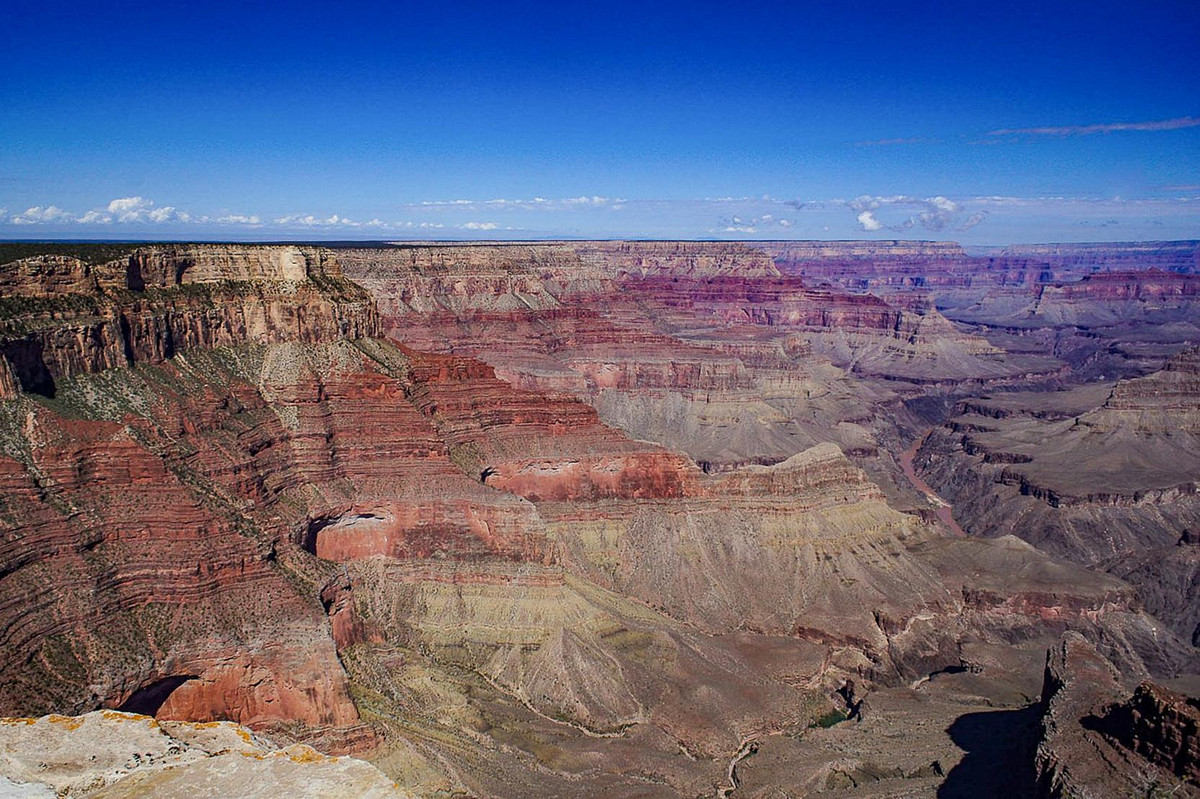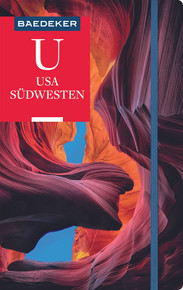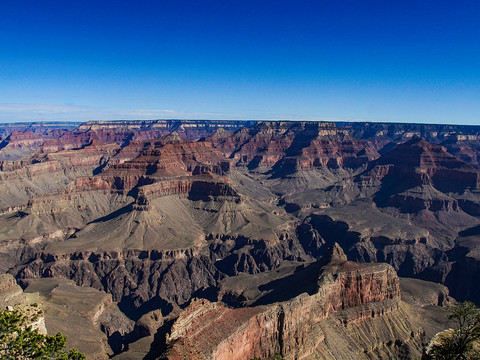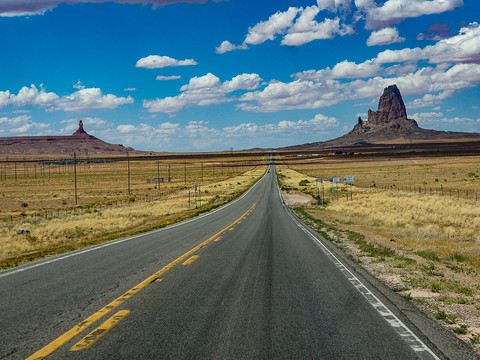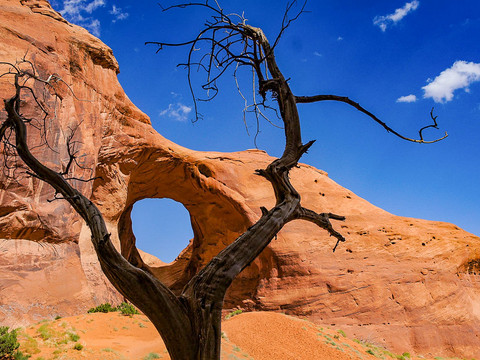Dramatic canyons, flowering cacti, old indigenous settlements and endless expanses - fascinating landscapes await you in Arizona. The state in the southwest of the USA combines natural spectacles with cultural diversity. Sun-seekers will get their money's worth in Arizona: Phoenix is the hottest place in the USA, with an average of 320 days of sunshine a year, and temperatures can rise to 46°C. Rent a camper and discover the desert state at your own pace.
Our road trip starts just before the New Mexico border, in the middle of the Wild West. Welcome to Tombstone, a western town with the inviting epithet "The Town Too Tough To Die". Once Wyatt Earp and Billy the Kid called the shots here, today it's the numerous tourists. The town, which essentially consists of the traffic-free main street Allen Street, exudes pure Wild West feeling with its numerous saloons and wooden houses. At the O.K. Corral, the heroes of yesteryear stand in wax and ready to fire. The historic shoot-out is revived several times a day. In the Historama next door, a multimedia show tells the story of the place. In the evening, a visit to a saloon is worthwhile, pure Wild West, preferably Big Nose Kate's.
After this historical prelude, you will find tranquillity and saguaro cacti behind Tucson in the western part of the Saguaro National Park, which make for a great photo backdrop, most beautiful at sunset. The giant saguaros are considered the universal symbol of the American West. Here in the national park of the same name, some of the most impressive cactus forests of these subtropical giants are protected. Their main trunk can grow up to 15 metres high, and the first arms only form after 70 years. In May/June, the white, waxy flowers are particularly beautiful. Also, don't miss a visit to the Arizona-Sonora Desert Museum. A combination of botanical garden and small animal zoo shows the flora and fauna of the Sonora Desert. More than 300 animal species native to the desert are housed in an exemplary manner among numerous cacti and around 1200 plant species.
The journey continues to Phoenix. The capital of Arizona with 4.5 million inhabitants is famous for its numerous cultural and scenic visitor magnets: plenty of greenery at the Desert Botanical Garden and Ro He En Japanese Friendship Garden; animals at the Ody-Sea Aquarium, Butterfly Wonderland and Phoenix Zoo; tranquillity at South Mountain Park and Adobe Dam Regional Park; as well as various museums such as the Science Museum with numerous interactive exhibits, attached planetarium and a huge cinema screen.
On the way northeast, it is worth taking a detour to Sunset Crater Volcano National Monument, a nature reserve north of Flagstaff. Sunset Crater is a small volcano whose black-red cone offers a great contrast to the surrounding green pine forests. On an educational trail below the 340-metre-high ash cone, visitors learn more about the different types of lava rock.
Instead of heading straight for the Grand Canyon, it is worth taking a detour through eastern Arizona. Follow Interstate 40 to Holbrook before you reach the next national park. In Petrified Forest National Park you will find the world's largest and most colourful concentration of petrified wood. Old tree trunks turned to stone 200 million years ago through erosion and make a bizarre picture. First visit the southern part of the park with its high density of colourful woods and later enjoy the sunset at a viewpoint in the northern area with a far-reaching view over the reddish-brown "badlands" of the Painted Desert. The film on the formation of the fossils at the Painted Desert Visitor Centre is very informative.
Canyon de Chelly National Monument is located about an hour's drive northeast of the Painted Desert, right on the Utah state border. Canyon de Chelly guarantees you a spectacular panorama and fascinating insights into the traditional way of life of the Native Americans. The dramatic sandstone canyon is located on the reservation land of the Navajo Nation and houses centuries-old petroglyphs and dwellings of the early Pueblo culture as well as campsites and carvings of tribes from the Archaic period who lived in the canyon thousands of years ago. The land has been home to the Navajos for over 300 years. The minimum programme of a visit is to drive down the South Rim Road to numerous viewpoints along the canyon. Don't miss the short trail to Spider Rock Overlook, a photogenic rock outcrop.
The legendary Monument Valley, which has served as a backdrop in numerous films, is also a must-see in Arizona. The silhouette of the three striking monoliths East Mitten, West Mitten as well as Merrick Butte awakens longings and leaves one humbled. The visitor centre is located on the edge of the plain below which the valley with the monuments extends. It is also the starting point for the dusty 17-mile ride down to the rust-coloured rocks. Horseback riding tours lasting several hours can be booked, as can impressive balloon rides that allow you to experience the landscape from a completely new perspective. Be sure to stay overnight right next to the Visitor Centre at "The View" campsite - sunset included.
Just under two hours away, the small town of Page in the Arizona desert beckons, a tourist hub for Lake Powell. Just 7500 people live here and there are only a handful of restaurants and bars. It is the surrounding nature that makes Page so attractive. The Lake Powell reservoir is just one of the visitor magnets; the region resembles a gigantic open-air museum with fabulous natural wonders made of sandstone. Hiring a boat on Lake Powell to admire the sandstone worlds from the water is not cheap, but highly recommended. A visit to the 210-metre-high Glen Canyon Dam, which dams up the Colorado River, is definitely worthwhile.
You should definitely not miss the "Horseshoe Bend": A short trail leads to a cliff edge from where you can enjoy a breathtaking view of the 180-degree bend of the Colorado River. A magnificent photo motif! You can also take great photos during a visit to Antelope Canyon. Over millions of years, water and wind have carved a deep and narrow canyon into the red sandstone. The more spectacular "Upper Canyon" is at first not much more than an inconspicuous crack in a rock at its entrances. But as you dive in, this slot canyon transports you into a world of bizarrely shaped, gently curved or angularly sharp sandstone formations. Only a little light enters the narrow canyon through the small openings at the upper canyon rim. The light reflects off the sandstone, creating an impressive palette of warm, reddish-purple colours. My tip: A visit at midday is particularly spectacular and worthwhile when the sun shines vertically into the canyon and the resulting columns of light touch the ground. An indescribable natural spectacle!
An equally spectacular natural wonder awaits not far from Page: 2000 metres deep, 400km long and 30km wide - the Grand Canyon, the largest canyon in the world, is a must on any Arizona tour! The oversized canyon cannot be described in words; you have to see with your own eyes the dimensions of this natural wonder. Over millions of years, the powerful waters of the Colorado River have carved deep gorges into the rock of the Colorado Plateau. It is an awe-inspiring feeling when you look over the canyon rim into the deep gorges for the first time. It's an incredible, almost surreal sight - you become quite small, humble and still.
There are two ways to experience the Grand Canyon: either via the South Rim or the North Rim - as the "edges" of the canyon are called. The South Rim is the most visited point at the Grand Canyon due to its tourist infrastructure in the Grand Canyon Village and the better accessibility. Unlike the North Rim, it is open all year round. From various vantage points along the Rim trail you can enjoy the stunning view into the canyon. If you like hiking and have a certain level of fitness, you should dare to make the strenuous descent and return to the Colorado River. Because of the many metres in altitude, this is not an easy thing to do, and quite a few people have overestimated themselves. If you are not afraid of water, you can conquer the canyon on a rafting tour. Or you can treat yourself to something even more exclusive: with the necessary change, you can get the most beautiful overview and insight into the largest canyon in the world on a helicopter flight.

To properly prepare for your trip
How you get there:
non-stop from Zurich with Edelweiss to Las Vegas
How long am I supposed to go:
2 - 3 weeks round trip
Best travel time:
All year round
Highlights:
Grand Canyon, Tombstone, Monument Valley, Antelope Canyon, Horseshow Bend
Accommodation tip:
https://monumentvalleyview.com
Restaurant Tip:
https://bignosekatestombstone.com
More tips for trips:
www.getyourguide.ch
More info:
https://www.visitarizona.com
Realised by Michael Bachmann
Further travel pictures under www.kissed-by-nature.com









